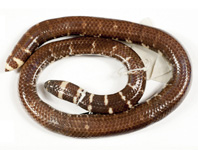Abstract
A new species of viperine viperid snake is described, Bitis harenna sp. nov. The new species is a member of the subgenus Macrocerastes based on it having three scales separating the nasal and rostral shields, and on the combination of ‘divisions’ of dorsal scale rows on the upper flanks and ‘fusions’ of rows on the lower flanks. Bitis harenna sp. nov. is distinguished from other members of the subgenus by its unique colour pattern, posterior parietal flange on the lateral wall of the braincase, and possibly by differences in scalation and head proportions. Only a single museum specimen is known, a female collected from ‘Dodola’ in Ethiopia probably in the late 1960s and previously identified as a possibly unusually coloured and patterned B. parviocula. A live, presumably male, specimen very closely resembling the holotype of Bitis harenna sp. nov. was photographed on the Harenna escarpment of the Bale Mountains National Park, Ethiopia in 2013, providing secure occurrence data and evidence that the holotype is not a uniquely aberrant specimen. A revised key to the species of Bitis in Ethiopia is presented. Aspects of body scalation are compared among species of the subgenus Macrocerastes and between species of Macrocerastes and Bitis, and several systematic characters are highlighted and clarified.
References
Beyerlein, P. (1993) Untersuchungen zur systematischen Relevanz epidermaler Ultrastrukturen bei modernen Schlangen (Colubroidea). Unpublished Masters thesis, University of Bonn, Bonn, 108 pp.
Böhme, W. (1977) Eine neue Art der Gattung Bitis (Serpentes Viperidae) aus Äthiopien. Monitore Zoologico Italiano, Nuova Serie, Supplemento, 9, 59–68.
Böhme, W. (1990) Was ist Kryptozoologie? Tier und Museum, 2, 9–14.
Branch, W.R. (1978) The venomous snakes of southern Africa. Part I. Introduction and Viperidae. The Snake, 9, 67–86.
Branch, W.R. (1988) A Field Guide to the Snakes and other Reptiles of southern Africa. New Holland Publishers Ltd, London, 326 pp.
Dobiey, M. & Vogel, G. (2007) Venomous snakes of Africa. Giftschlangen Afrikas. Edition Chimaira, Frankfurt am Main, 148 pp.
Dowling, H.G. (1951a) A proposed standard system of counting ventrals in snakes. British Journal of Herpetology, 1, 97–99.
Dowling, H.G. (1951b) A proposed method of expressing scale reductions in snakes. Copeia, 1951, 131–134.
http://dx.doi.org/10.2307/1437542Feldkamp, L.A., Davis, L.C. & Kress, J.W. (1984) Practical cone-mean algorithm. Journal of the Optical Society of America, 1, 612–619.
http://dx.doi.org/10.1364/JOSAA.1.000612Geniez, P., Mateo, J.A., Geniez, M. & Pether, J. (2004) The amphibians and reptiles of the Western Sahara (former Spanish Sahara) and adjacent regions. Edition Chimaira, Frankfurt am Main, 228 pp.
Gower, D.J., Aberra, R.K., Schwaller, S., Largen, M.J., Collen, B., Spawls, S., Menegon, M., Zimkus, B.M., de Sá, R., Mengistu, A.A., Gebresenbet, F., Moore, R.D., Saber, S.A. & Loader, S.P. (2013) Long-term data for endemic frog genera reveal potential conservation crisis in the Bale Mountains, Ethiopia. Oryx, 47, 59–69.
http://dx.doi.org/10.1017/S0030605311001426Groombridge, B.C. (1980) A phyletic analysis of viperine snakes. Unpublished PhD thesis, City of London Polytechnic, London, 271 pp.
Hughes, B. (1968) An unusual rhinoceros viper, Bitis nasicornis, from Ghana, West Africa. Zoologische Mededelingen, 43, 107–115.
Hughes, B. (2012) Snakes of Bénin, West Africa. Bulletin de la Société Herpétologique de France, 144, 101–159.
Largen, M.J. & Rasmussen, J.B. (1993) A catalogue of the snakes of Ethiopia (Reptilia Serpentes), including identification keys. Tropical Zoology, 6, 313–434.
http://dx.doi.org/10.1080/03946975.1993.10539231Largen, M.J. & Spawls, S. (2010) The amphibians and reptiles of Ethiopia and Eritrea. Edition Chimaira, Frankfurt am Main, 693 pp.
Lenk, P., Herrmann, H.-W., Joger, U. & Wink, M. (1999) Phylogeny and taxonomic subdivision of Bitis (Reptilia: Viperidae) based on molecular evidence. Kaupia – Darmstädter Beiträge zur Naturgeschichte, 8, 31–38.
Limaye, A. (2012) Drishti: a volume exploration and presentation tool. Proceedings of SPIE. Developments in X-Ray Tomography, VIII, 85060X.
http://dx.doi.org/10.1117/12.935640Nečas, P. (1997) Five endemic montane snakes from Ethiopia. Reptile and Amphibian Magazine, 49, 58--–65.
Nečas, P., Lizler, R. & Trailin, V. (1993a) Nachtrag zur Biologie zweier seltener Schlangenarten aus Äthiopien: Bitis parviocula Böhme, 1977 und Pseudoboodon boehmei Rasmussen & Largen, 1992, mit Bemerkungen zur Wiederentdeckung von Lamprophis erlangeri (Sternfeld, 1908). Herpetofauna, 15, 17–20.
Nečas, P., Lizler, R. & Trailin, V. (1993b) Über die Biologie zweier seltener Schlangenarten aus Äthiopien: Bitis parviocula Böhme, 1977 und Pseudoboodon boehmei Rasmussen & Largen, 1992. Herpetofauna, 15, 6–13.
Spawls, S. (1994) The herpetofauna of Ethiopia. Part 2. The forests and the mountains. Reptilian, 2, 7–14.
Spawls, S. & Branch, B. (1995) Dangerous snakes of Africa. Ralph Curtis Publishing, Sanibel Island, Florida, 192 pp.
Wallach, V., Williams, K.L. & Boundy, J. (2014) Snakes of the World: A catalogue of living and extinct species. CRC Press, Boca Raton, Florida, 1237 pp.
http://dx.doi.org/10.1201/b16901Wittenberg, R.D., Jadin, R.C., Fenwick, A.M. & Gutberlet, R.L. (2015) Recovering the evolutionary history of Africa’s most diverse viper genus: morphological and molecular phylogeny of Bitis (Reptilia: Squamata: Viperidae). Organisms, Diversity & Evolution, 15, 115–125.
http://dx.doi.org/10.1007/s13127-014-0185-3Wüster, W., Peppin, L., Pook, C.E. & Walker, D.E. (2008) A nesting of vipers: Phylogeny and historical biogeography of the Viperidae (Squamata: Serpentes). Molecular Phylogenetics and Evolution, 49, 445–459.
http://dx.doi.org/10.1016/j.ympev.2008.08.019

